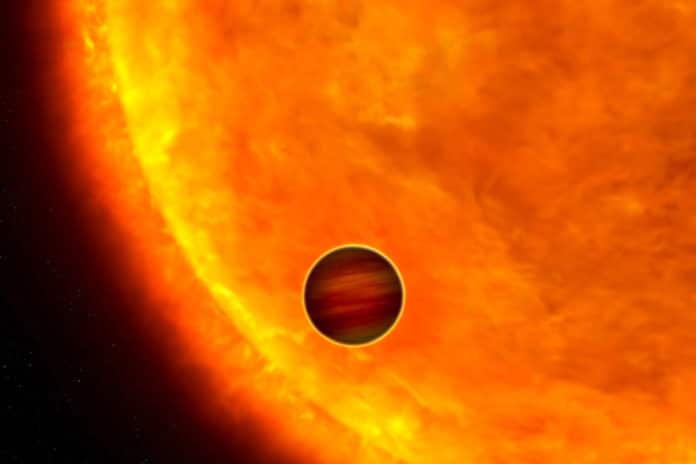Most of the exoplanets discovered to date are hot Jupiters. These exoplanets orbit their stars in less than ten days. Until now, scientists have found about 400 hot Jupiters.
Now, astronomers have discovered one of the most extreme ultrahot Jupiters designated TOI-2109b. This gas giant is almost five times Jupiter’s mass and orbits its star in just 16 hours. The orbit of the planet around the star is the shortest of any known gas giant to date.
The planet’s dayside is estimated to be at around 3,500 Kelvin, or close to 6,000 degrees Fahrenheit. This makes the object the second hottest detected so far.
Based on its properties, this ultrahot Jupiter is believed to be in the process of ‘orbital decay. Due to its short orbit, the planet is spiraling toward its star faster than other hot Jupiters.
Ian Wong, a lead author of the discovery, who was a postdoc at MIT during the study and has since moved to NASA Goddard Space Flight Center, said, “In one or two years if we are lucky, we may be able to detect how the planet moves closer to its star. In our lifetime, we will not see the planet fall into its star. But give it another 10 million years, and this planet might not be there.”
The star TOI-2109 is located in the southern portion of the Hercules constellation, about 855 light-years from Earth. A month after its discovery, the TESS spacecraft collected measurements of the star’s light. The light was then analyzed for transits. The data from TESS confirmed that the star indeed hosts an object that orbits about every 16 hours at a rate of 10 to 750 milliseconds per year.
The star is about 50 percent larger in size and mass compared to our Sun.
Multiple ground-based telescopes followed up over the next year to observe the star more closely over a range of frequency bands. Combined with TESS’ initial detection, these observations confirmed the transiting object as an orbiting planet, designated TOI-2109b.
Observation at various optical and infrared wavelengths suggests that TOI-2109b is about five times as massive as Jupiter. It is incredibly close to its star- about 1.5 million miles out.
Like most hot Jupiters, the planet appears to be tidally locked, with a perpetual day and night side. Thanks to TESS observations, the team witnessed the planet’s varying brightness as it revolves about its axis.
Study co-author Avi Shporer, a research scientist at MIT’s Kavli Institute for Astrophysics and Space Research, said, “Meanwhile, the planet’s night side brightness is below the sensitivity of the TESS data, which raises questions about what is happening there. Is the temperature very cold, or does the planet somehow take the heat on the dayside and transfer it to the night side? We’re at the beginning of trying to answer this question for these ultrahot Jupiters.”
The team is now planning to observe this newly discovered ultrahot Jupiter using more powerful tools in the near future. Detailed observations could illuminate the conditions hot Jupiters undergo as they fall into their star.
Ian Wong, a lead author of the discovery, a postdoc at MIT during the study, and has since moved to NASA Goddard Space Flight Center, said, “Ultrahot Jupiters such as TOI-2109b constitute the most extreme subclass of an exoplanet. We have only just started to understand some of the unique physical and chemical processes that occur in their atmospheres — processes that have no analogs in our solar system.”
Shporer said, “From the beginning of exoplanetary science, hot Jupiters have been seen as oddballs. How does a planet as massive and large as Jupiter reach an orbit only a few days long? We don’t have anything like this in our solar system, and we see this as an opportunity to study them and help explain their existence.”
Journal Reference:
- Ian Wong et al. TOI-2109: An Ultrahot Gas Giant on a 16 hr Orbit. DOI: 10.3847/1538-3881/ac26bd
